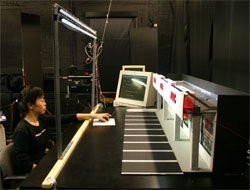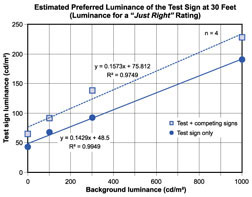|

Luminance Requirements for Commercial Signs (2006)


A mock strip mall, complete with parking spaces, was built at the LRC's laboratory to evaluate people's luminance preferences for backlighted channel-letter signs.

Preferred sign luminance at a 30-ft. viewing distance as a function of background luminance. Top line is for the test sign viewed amid competing signs. Bottom line is for the test sign viewed alone.
|
LEDs are fast becoming a popular choice for backlighting channel-letter signs because they offer energy savings and better performance in some instances over neon and fluorescent lamps. Retailers, restaurants, and other businesses open at night rely on signs to attract customers, yet few guidelines exist to direct the brightness of these signs. To better understand the requirements for lighted signage, the Lighting Research Center investigated the luminance of backlighted, channel-letter signs.
BACKGROUND
To become a successful replacement for neon and fluorescent lamps in signage applications, LEDs have to not only match the performance of these light sources, but also meet the subjective standards of viewers. One subjective standard is brightness, an important determinant of a sign's readability and capability of attracting attention. Because no standards presently exist in North America for sign brightness based on visibility, a common practice for LEDs has been to match the luminance of neon signs, and in some cases, create signs that are brighter than those of adjacent businesses. This practice has drawbacks, including higher energy use and the potential for light pollution.
EXPERIMENT
A human-factors study was conducted to identify a suitable range of luminances for red channel-letter signs. Using a scale model of a mock strip mall, subjects evaluated the brightness acceptability and ease-of-reading of several sign luminances under different background lighting conditions commonly found outdoors at night and during the day inside a shopping mall. The sign luminances were evaluated at 30 feet, 60 feet, and 340 feet. Subjects also considered how the presence of adjacent, competing signs affected their perceptions of brightness.
RESULTS
LRC researchers found statistically different preferences for sign brightness at each of the four background light levels, with brighter backgrounds calling for brighter signs.
For stand-alone signs, the most acceptable sign luminances fell between 40 cd/m2 and 190 cd/m2. When adjacent signs were present, subjects preferred a higher sign brightness. For these conditions, the most preferred sign luminance ranged from 65 cd/m2 to 230 cd/m2. However, this preference had little to do with the brightness of the adjacent signs. Adding the adjacent signs likely increased the overall luminance of the background, which led to a preference for a brighter sign. Similarly, an increased viewing distance indicated a preference for brighter signs.
In a limited, local field survey, LRC researchers found that the luminance of typical red channel-letter signs ranged between 100 cd/m2 and 450 cd/m2, depending on the size and light source used.
TECHNICAL PAPER
Freyssinier, J.P., N. Narendran, and J.D. Bullough. 2006. Luminance requirements for lighted signage. Sixth International Conference on Solid State Lighting, Proceedings of SPIE 6337, 63371M.
Full-text PDF 
RELATED NEWS
LRC Project Sheet 
LRC Investigates Luminance Requirements for Signage — LRC Newsletter, October 2006
SPONSORS
New York State Energy Research and Development Authority (NYSERDA)
RPC Photonics
|


